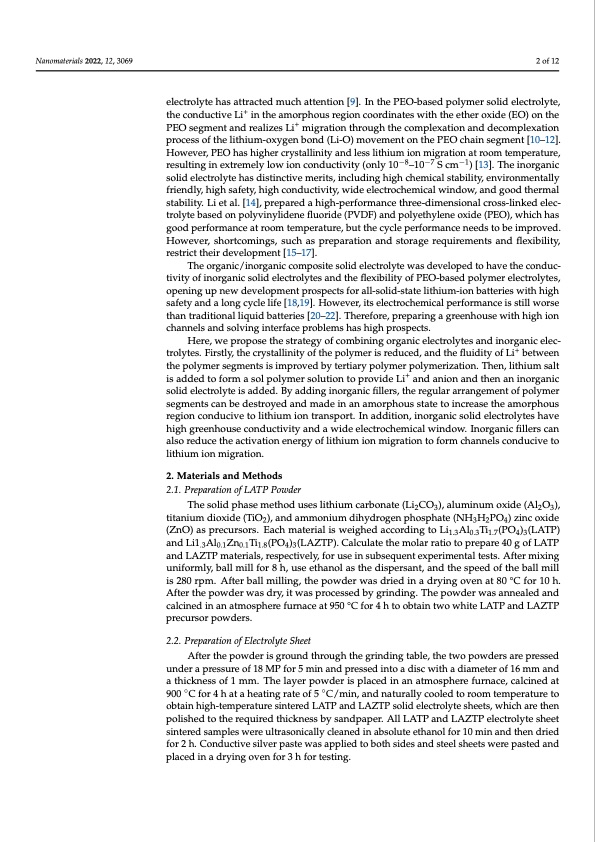
PDF Publication Title:
Text from PDF Page: 002
Nanomaterials 2022, 12, 3069 2 of 12 electrolyte has attracted much attention [9]. In the PEO-based polymer solid electrolyte, the conductive Li+ in the amorphous region coordinates with the ether oxide (EO) on the PEO segment and realizes Li+ migration through the complexation and decomplexation process of the lithium-oxygen bond (Li-O) movement on the PEO chain segment [10–12]. However, PEO has higher crystallinity and less lithium ion migration at room temperature, resulting in extremely low ion conductivity (only 10−8–10−7 S cm−1) [13]. The inorganic solid electrolyte has distinctive merits, including high chemical stability, environmentally friendly, high safety, high conductivity, wide electrochemical window, and good thermal stability. Li et al. [14], prepared a high-performance three-dimensional cross-linked elec- trolyte based on polyvinylidene fluoride (PVDF) and polyethylene oxide (PEO), which has good performance at room temperature, but the cycle performance needs to be improved. However, shortcomings, such as preparation and storage requirements and flexibility, restrict their development [15–17]. The organic/inorganic composite solid electrolyte was developed to have the conduc- tivity of inorganic solid electrolytes and the flexibility of PEO-based polymer electrolytes, opening up new development prospects for all-solid-state lithium-ion batteries with high safety and a long cycle life [18,19]. However, its electrochemical performance is still worse than traditional liquid batteries [20–22]. Therefore, preparing a greenhouse with high ion channels and solving interface problems has high prospects. Here, we propose the strategy of combining organic electrolytes and inorganic elec- trolytes. Firstly, the crystallinity of the polymer is reduced, and the fluidity of Li+ between the polymer segments is improved by tertiary polymer polymerization. Then, lithium salt is added to form a sol polymer solution to provide Li+ and anion and then an inorganic solid electrolyte is added. By adding inorganic fillers, the regular arrangement of polymer segments can be destroyed and made in an amorphous state to increase the amorphous region conducive to lithium ion transport. In addition, inorganic solid electrolytes have high greenhouse conductivity and a wide electrochemical window. Inorganic fillers can also reduce the activation energy of lithium ion migration to form channels conducive to lithium ion migration. 2. Materials and Methods 2.1. Preparation of LATP Powder The solid phase method uses lithium carbonate (Li2CO3), aluminum oxide (Al2O3), titanium dioxide (TiO2), and ammonium dihydrogen phosphate (NH3H2PO4) zinc oxide (ZnO) as precursors. Each material is weighed according to Li1.3Al0.3Ti1.7(PO4)3(LATP) and Li1.3Al0.1Zn0.1Ti1.8(PO4)3(LAZTP). Calculate the molar ratio to prepare 40 g of LATP and LAZTP materials, respectively, for use in subsequent experimental tests. After mixing uniformly, ball mill for 8 h, use ethanol as the dispersant, and the speed of the ball mill is 280 rpm. After ball milling, the powder was dried in a drying oven at 80 °C for 10 h. After the powder was dry, it was processed by grinding. The powder was annealed and calcined in an atmosphere furnace at 950 °C for 4 h to obtain two white LATP and LAZTP precursor powders. 2.2. Preparation of Electrolyte Sheet After the powder is ground through the grinding table, the two powders are pressed under a pressure of 18 MP for 5 min and pressed into a disc with a diameter of 16 mm and a thickness of 1 mm. The layer powder is placed in an atmosphere furnace, calcined at 900 ◦C for 4 h at a heating rate of 5 ◦C/min, and naturally cooled to room temperature to obtain high-temperature sintered LATP and LAZTP solid electrolyte sheets, which are then polished to the required thickness by sandpaper. All LATP and LAZTP electrolyte sheet sintered samples were ultrasonically cleaned in absolute ethanol for 10 min and then dried for 2 h. Conductive silver paste was applied to both sides and steel sheets were pasted and placed in a drying oven for 3 h for testing.PDF Image | Simple Three-Matrix Solid Electrolyte Membrane in Air

PDF Search Title:
Simple Three-Matrix Solid Electrolyte Membrane in AirOriginal File Name Searched:
nanomaterials-12-03069.pdfDIY PDF Search: Google It | Yahoo | Bing
Product and Development Focus for Salgenx
Redox Flow Battery Technology: With the advent of the new USA tax credits for producing and selling batteries ($35/kW) we are focussing on a simple flow battery using shipping containers as the modular electrolyte storage units with tax credits up to $140,000 per system. Our main focus is on the salt battery. This battery can be used for both thermal and electrical storage applications. We call it the Cogeneration Battery or Cogen Battery. One project is converting salt (brine) based water conditioners to simultaneously produce power. In addition, there are many opportunities to extract Lithium from brine (salt lakes, groundwater, and producer water).Salt water or brine are huge sources for lithium. Most of the worlds lithium is acquired from a brine source. It's even in seawater in a low concentration. Brine is also a byproduct of huge powerplants, which can now use that as an electrolyte and a huge flow battery (which allows storage at the source).We welcome any business and equipment inquiries, as well as licensing our flow battery manufacturing.| CONTACT TEL: 608-238-6001 Email: greg@salgenx.com | RSS | AMP |